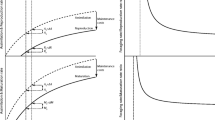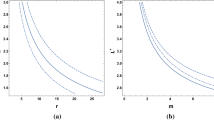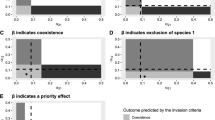Abstract
Discrete stage-structured density-dependent and discrete age-structured density-dependent population models are considered. Regarding the former, we prove that the model at hand is permanent (i.e., that the population will neither go extinct nor exhibit explosive oscillations) and given density dependent fecundity terms we also show that species with delayed semelparous life histories tend to be more stable than species which possess precocious semelparous life histories. Moreover, our findings together with results obtained from other stage-structured models seem to illustrate a fairly general ecological principle, namely that iteroparous species are more stable than semelparous species. Our analysis of various age-structured models does not necessarily support the conclusions above. In fact, species with precocious life histories now appear to possess better stability properties than species with delayed life histories, especially in the iteroparous case. We also show that there are dynamical outcomes from semelparous age-structured models which we are not able to capture in corresponding stage-structured cases. Finally, both age- and stage-structured population models may generate periodic dynamics of low period (either exact or approximate). The important prerequisite is to assume density-dependent survival probabilities.






Similar content being viewed by others
References
Behncke, H. (2000). Periodical cicadas. J. Math. Biol., 40, 413–431.
Bergh, M. O., & Getz, W. M. (1988). Stability of discrete age-structured and aggregated delay-difference population models. J. Math. Biol., 26, 551–581.
Botsford, L. W. (1986). Population dynamics of the Dungeness crab (Cancer magister). Can. Spec. Publ. Fish. Aquat. Sci., 92, 140–153.
Botsford, L. W. (1992). Further analysis of Clark’s delayed recruitment model. Bull. Math. Biol., 54, 275–293.
Bulmer, M. G. (1977). Periodical insects. Am. Nat., 111, 1099–1117.
Caswell, H. (2001). Matrix population models. Sunderland: Sinauer Ass. Inc. Publishers.
Clark, C. W. (1976). A delayed recruitment model of population dynamics with an application to baleen whale population. J. Math. Biol., 3, 381–391.
Cooke, D., & Leon, J. A. (1976). Stability of population growth determined by 2×2 Leslie matrix with density dependent elements. Biometrics, 32, 435–442.
Costantino, R. F., Desharnais, R. A., Cushing, J. M., & Dennis, B. (1997). Chaotic dynamics in an insect population. Science, 275, 389–391.
Cushing, J. M. (1998). An introduction to structured population dynamics. Philadelphia: SIAM.
Cushing, J. M., Dennis, B., Desharnais, R. A., & Costantino, R. F. (1996). An interdisciplinary approach to understanding nonlinear ecological dynamics. Ecol. Model., 92, 111–119.
Cushing, J. M., Costantino, R. F., Dennis, B., Desharnais, R. A., & Henson, S. M. (1998). Nonlinear population dynamics: models, experiments and data. J. Theor. Biol., 194, 1–9.
Davydova, N. V., Diekman, O., & van Gils, S. A. (2003). Year class coexistence or competitive exclusion for strict biennials? J. Math. Biol., 46, 95–131.
Dennis, B., Desharnais, R. A., Cushing, J. M., & Costantino, R. F. (1997). Transition in population dynamics: equilibria to periodic cycles to aperiodic cycles. J. Anim. Ecol., 6b, 704–729.
Desharnais, R. A., & Liu, L. (1987). Stable demographic limit cycles in laboratory populations of Tribolium Castaneum. J. Anim. Ecol., 56, 885–906.
Elliott, J. M. (1994). Quantitative ecology and the Brown Trout. Oxford: Oxford University Press.
Fowler, C. W. (1980). Comparative population dynamics in large mammals. In Fowler, C. W. & Smith, T. D. (Eds.) Dynamics of large mammal populations. New York: Wiley
Govaerts, W., & Ghaziani, K. (2006). Numerical bifurcation analysis of a nonlinear stage structured cannibalism population model. J. Differ. Equ. Appl. 12, 1069–1085.
Guckenheimer, J., Oster, G., & Ipaktchi, A. (1977). The dynamics of density dependent population models. J. Math. Biol., 4, 101–147.
Hastings, A. (1984). Age dependent predation is not a simple process. II. Wolves, ungulates and a discrete time model for predation on juveniles with a stabilizing tail. Theor. Popul. Biol., 26, 271–282.
Higgins, K., Hastings, A., & Botsford, L. W. (1997). Density dependence and age structure: nonlinear dynamics and population behavior. Am. Nat., 149, 247–269.
International Whaling Commission (1979). Report no. 29, International Whaling Commission.
Kon, R. (2005). Nonexistence of synchronous orbits and class coexistence in matrix population models. SIAM J. Appl. Math., 66(2), 616–626.
Kon, R., Saito, Y., & Takeuchi, T. (2004). Permanence of single-species stage-structured models. J. Math. Biol., 48, 515–528.
Kot, M. (2001). Elements of mathematical ecology. Cambridge: Cambridge University Press.
Levin, S. A., & Goodyear, P. H. (1980). Analysis of an age-structured fishery model. J. Math. Biol., 9, 245–274.
Longstaff, B. C. (1977). The dynamics of collembolan populations: a matrix model of single species population growth. Can. J. Zool., 55, 314–324.
Mjølhus, E., Wikan, A., & Solberg, T. (2005). On synchronization in semelparous populations. J. Math. Biol., 50, 1–21.
Murray, J. D. (1993). Mathematical biology (2nd edn.). Berlin: Springer.
Neubert, M. G., & Caswell, H. (2000). Density-dependent vital rates and their population dynamic consequences. J. Math. Biol., 41, 103–121.
Ricker, W. E. (1954). Stock and recruitment. J. Fish. Res. Board Can., 11, 559–623.
Silva, J. A., & Hallam, T. G. (1993). Effects of delay, truncation and density dependence in reproduction schedules on stability of nonlinear Leslie matrix models. J. Math. Biol., 31, 367–395.
Solberg, T. (1998). Rare phenomena in an age-structured population model. Master thesis, University of Tromsø, Norway.
Stenseth, N. C., & Ims, R. A. (1993). Population dynamics of lemmings: temporal and spatial variation. In N. C. Stenseth & R. A. Ims (Eds.), The biology of lemmings. London: Academic Press.
Thunberg, H. (2001). Periodicity versus chaos in one-dimensional dynamics. SIAM Rev., 43, 3–30.
Tuljapurkar, S., Boe, C., & Wachter, K. W. (1994). Nonlinear feedback dynamics in fisheries: analysis of the Deriso–Schnute model. Can. J. Fish. Aquat. Sci., 51, 1462–1473.
Wikan, A. (1997). Dynamic consequences of reproductive delay in Leslie matrix models with nonlinear survival probabilities. Math. Biosci., 146, 37–62.
Wikan, A., & Eide, A. (2004). An analysis of a nonlinear stage-structured cannibalism model with application to the northeast Arctic cod stock. Bull. Math. Biol., 66, 1685–1704.
Wikan, A., & Mjølhus, E. (1995). Periodicity of 4 in age-structured population models with density dependence. J. Theor. Biol., 173, 109–119.
Wikan, A., & Mjølhus, E. (1996). Overcompensatory recruitment and generation delay in discrete age-structured population models. J. Math. Biol., 35, 195–239.
Author information
Authors and Affiliations
Corresponding author
Rights and permissions
About this article
Cite this article
Wikan, A. Age or Stage Structure?. Bull Math Biol 74, 1354–1378 (2012). https://doi.org/10.1007/s11538-012-9715-3
Received:
Accepted:
Published:
Issue Date:
DOI: https://doi.org/10.1007/s11538-012-9715-3




